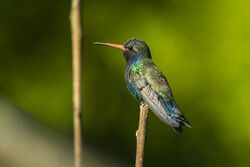Biology:Doubleday's hummingbird
| Doubleday's hummingbird | |
|---|---|

| |
| Scientific classification | |
| Domain: | Eukaryota |
| Kingdom: | Animalia |
| Phylum: | Chordata |
| Class: | Aves |
| Clade: | Strisores |
| Order: | Apodiformes |
| Family: | Trochilidae |
| Genus: | Cynanthus |
| Species: | C. doubledayi
|
| Binomial name | |
| Cynanthus doubledayi (Bourcier, 1847)
| |
Doubleday's hummingbird (Cynanthus doubledayi) is a species of hummingbird in the family Trochilidae also known as the turquoise-crowned hummingbird. Some taxonomic authorities, such as the American Ornithological Society consider this bird to be a subspecies of the broad-billed hummingbird, while others consider it distinct.
Geographic Range
Cynanthus doubledayi is found along the Pacific coast of south-west Mexico.[3]
Diet
Hummingbirds in generally eat;[4]
- Nectar;
- Insects;
- Spiders
- Larvae
- Insect eggs.
- Other such small insects
Insects provide critical nutrients like fat, protein and salts that nectar does not provide.
- Sap;
Sap is consumed when nectar is unavailable and contains enough scructose to sustain the hummingbird's energy use.
- Pollen;
Although pollen is not directly consumed an amount of pollen is stuck to the Hummingbird's beak thus being ingested, only about 10% of ingested pollen is actually digested and provides a small amount of protein.
References
- ↑ BirdLife International (2016). "Cynanthus doubledayi". IUCN Red List of Threatened Species 2016: e.T22725775A94902284. doi:10.2305/IUCN.UK.2016-3.RLTS.T22725775A94902284.en. https://www.iucnredlist.org/species/22725775/94902284. Retrieved 11 November 2021.
- ↑ "Appendices | CITES". https://cites.org/eng/app/appendices.php.
- ↑ "Cynanthus doubledayi range map". International Union for Conservation of Nature and Natural Resources. http://maps.iucnredlist.org/map.html?id=22725775.
- ↑ Peaker, M. (1990-01-01). "Nutritional requirements and diets for hummingbirds and sunbirds" (in en). International Zoo Yearbook 29 (1): 109–118. doi:10.1111/j.1748-1090.1990.tb03339.x. ISSN 1748-1090.
Wikidata ☰ Q2982553 entry


